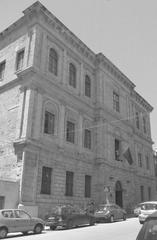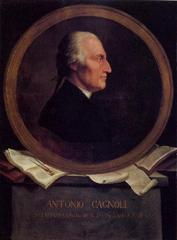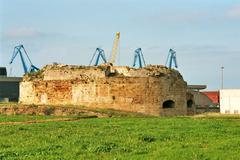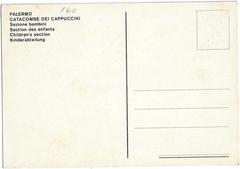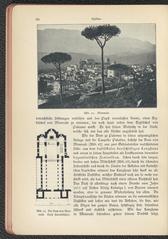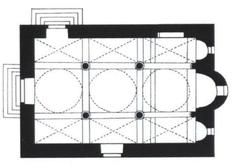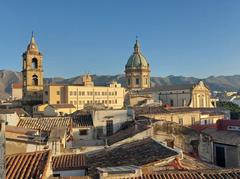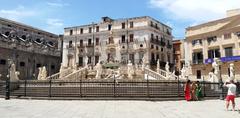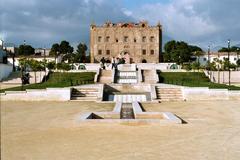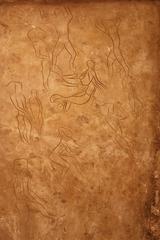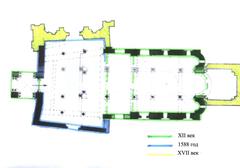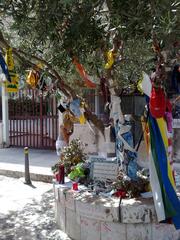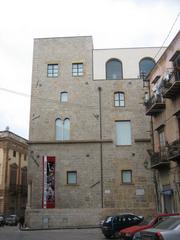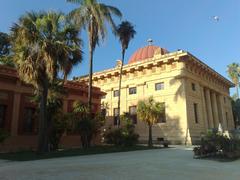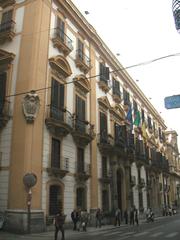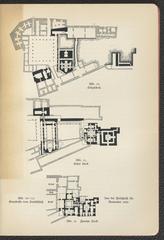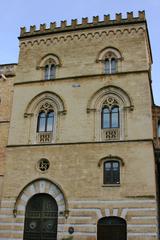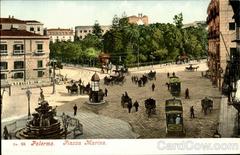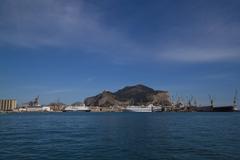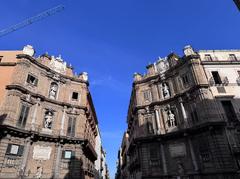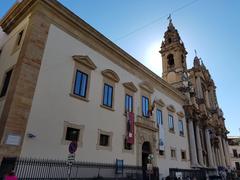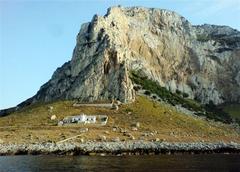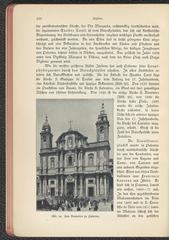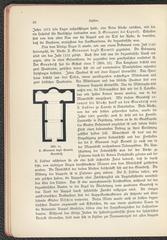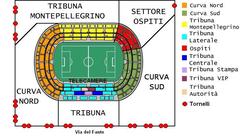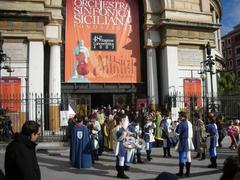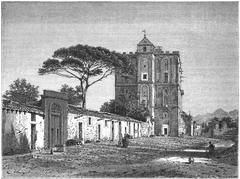
Teatro Garibaldi Palermo: Visiting Hours, Tickets, and History Guide
Date: 04/07/2025
Introduction
Teatro Garibaldi, located in Palermo’s historic Kalsa district, serves as a vibrant testament to the city’s artistic legacy and ongoing cultural revival. Founded in the 19th century and named after the Italian unification hero Giuseppe Garibaldi, the theatre has played many roles—from hosting operas and civic gatherings to becoming a contemporary hub for artistic innovation. This guide provides an in-depth exploration of Teatro Garibaldi’s architectural features, historical milestones, visiting hours, ticketing, and visitor tips to ensure a memorable experience in one of Palermo’s most cherished venues (Teatro Garibaldi Palermo visiting hours, tickets, and historical insights; Be Sicily Mag; Manifesta 12).
Origins and Construction
Teatro Garibaldi emerged during a transformative era for Palermo, reflecting the city’s aspirations during the Italian Risorgimento. Completed in 1861—a year marking Italy’s unification—the theatre was built in the gardens of Palazzo Ajutamicristo and designed in the “teatro all’italiana” tradition, featuring a horseshoe-shaped auditorium and tiered boxes. Its dedication to Garibaldi celebrated national unity and civic pride, establishing the venue as a focal point for Palermo’s burgeoning bourgeoisie and intellectual class.
Architectural Features
- Façade and Exterior: The exterior is defined by harmonious symmetry, a modest portico, and the use of local stone, blending seamlessly with the Kalsa district’s urban fabric. Compared to Palermo’s grander theatres, Teatro Garibaldi’s façade is restrained, adding to its unique charm (Comune di Palermo).
- Auditorium and Interior: Inside, the theatre follows the classic Italian horseshoe layout, with three tiers of boxes and a gallery. Originally, the stage curtain by Giuseppe Bagnasco depicted Garibaldi at Piazza Pretoria, symbolizing the theatre’s patriotic origins, though many original decorations have been lost.
- Restoration and Adaptation: After decades of neglect, restoration began in the 1990s, preserving the historic masonry while adapting the theatre for modern use. The minimalist interior, marked by exposed stone and plaster, now hosts flexible configurations for diverse events (Manifesta 12).
Historical Role and Cultural Significance
Since its inauguration, Teatro Garibaldi has been a central player in Palermo’s cultural life. It has hosted operas, plays, concerts, and, in modern times, international art events like Manifesta 12 and the Transeuropa Festival. The theatre’s legacy as a venue for civic engagement and cultural discourse mirrors the ideals of the Risorgimento and continues today through programs that foster social inclusion and intercultural dialogue.
Restoration and Modern Revival
Following periods of use as a cinema and even a boxing venue, Teatro Garibaldi closed in 1973 and fell into disrepair. Restoration projects—particularly since the 1990s—have revived the theatre, balancing respect for its historic character with the needs of contemporary audiences. Today, under the management of Fondazione Studio Rizoma, the space has become a model for adaptive reuse, hosting avant-garde performances, multimedia installations, and community events (Be Sicily Mag).
Community Engagement and Urban Impact
Teatro Garibaldi stands out for its commitment to accessibility and social inclusion, offering workshops, artist residencies, and educational programs that engage diverse communities—including youth, migrants, and marginalized groups. Its revitalization has contributed to the regeneration of the Kalsa district, attracting visitors and supporting local businesses.
Visitor Information
Visiting Hours
- General Access: Open Tuesday to Sunday, typically from 10:00 AM to 7:00 PM; closed on Mondays except during special events or performances.
- Event Hours: For performances and exhibitions, hours may extend into the evening. Always verify programming on the official website.
Tickets and Admission
- Pricing: Standard admission ranges from €10 to €25 per event. Discounts are available for students, seniors, and local residents.
- How to Buy: Tickets can be purchased online via the official website or at the theatre’s box office. Advance booking is recommended for popular events.
Guided Tours
- Availability: Regular guided tours are offered, especially during festivals. These provide insights into the theatre’s history, architecture, and cultural role.
- Booking: Reserve in advance, especially for group or private tours.
Accessibility
- Facilities: The building offers wheelchair access and assistive listening devices. Some historic features may present challenges; contact the theatre for tailored assistance.
Getting There
- Location: Centrally positioned in the Kalsa district, near Basilica La Magione.
- Transport: Easily accessible by bus, taxi, or on foot. Parking is limited due to ZTL (restricted traffic) zones.
Nearby Attractions and Amenities
- Landmarks: Palazzo Abatellis, Santa Maria dello Spasimo, Ballarò and Vucciria markets, Piazza Pretoria.
- Dining and Accommodation: Numerous options in La Kalsa, from traditional trattorias to boutique hotels.
- Additional Theatres: Consider visiting Teatro Massimo and Teatro Politeama.
Visitor Etiquette and Practical Tips
- Dress Code: Smart-casual attire is recommended for evening performances.
- Photography: Allowed in public areas before and after events; prohibited during performances unless otherwise stated.
- Arrival: Arrive 20–30 minutes early for popular events.
- Language: Performances are often in Italian; check for English-language shows or translation services.
FAQ
What are Teatro Garibaldi’s visiting hours?
Open Tuesday to Sunday, 10:00 AM–7:00 PM; closed Mondays except for special events. Always check the current schedule online.
How do I purchase tickets?
Tickets are available online and at the box office. Advance booking is recommended.
Is the theatre wheelchair accessible?
Yes, with modern accessibility features; contact ahead for specific needs.
Are guided tours offered?
Yes, especially during festivals or by appointment for groups.
Can I take photos inside?
Photography is generally permitted before and after events, but not during performances.
Visuals and Media Suggestions
- Feature high-resolution images of the theatre’s façade, auditorium, and restored interior.
- Use alt tags such as “Teatro Garibaldi Palermo facade” and “Interior horseshoe-shaped auditorium.”
- Link to virtual tours or video content from recent performances or festivals.
Summary & Tips
Teatro Garibaldi exemplifies the blend of traditional heritage and contemporary culture that defines Palermo. Its adaptive reuse, community engagement, and accessible programming make it a must-visit for travelers interested in the arts and history. For the best experience, consult the theatre’s official channels for up-to-date visiting hours, book tickets in advance, and consider combining your visit with exploration of nearby historic attractions.
Sources and Further Reading
- Teatro Garibaldi Palermo: Visiting Hours, Tickets, and Historical Insights
- Teatro Garibaldi Palermo: Visiting Hours, Tickets, and Cultural Significance, Be Sicily Mag
- Teatro Garibaldi in Palermo: Architectural Marvel, Visitor Guide, and Cultural Significance, Comune di Palermo & Manifesta 12
- Teatro Garibaldi Visiting Hours, Tickets, and Guide to Palermo’s Historic Theatre, Wikipedia


